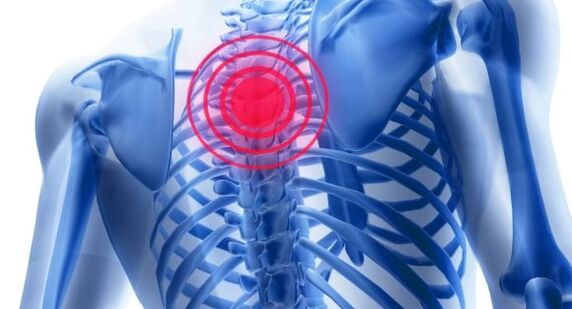
Torakal osteochondrosis- This is a dystrophic change in the interfaced discs, localized in thoracic spine.The treatment of the disease is needed to start immediately after making diagnosis, because the disease can quickly enter the chronic shape.
The main symptoms of the disease are the limitability of the shoulder carrier, shortness of breath, discomfort in the stomach and the pain in the chest that are provided in the heart.The danger to the patient is that the symptoms of osteochondrosis often confuse with cardiovascular diseases, so therapy is carried out by the wrong disease.
Causes of osteochondrose
Thoracic osteochondrosis is created as a result of pathological changes in vertebrae and intervertebral discs, as well as damaged blood supply and nutrition.In addition, the disease can be caused by the deformation of the spine.
Especially often people who are in a sitting position suffer from the symptoms of osteochondorosis of breast.These are basically office workers and students of different ages.Due to permanent sitting without observing the correct body position, the load on the vertebral increases significantly, which causes their deformation.
Root causes of disease:
- Increased load on the spine that occurs when raising the weights
- Age-Reficated changes in the body
- overweight
- Injuries to the spine department
- A predisposition on the genetic level
Depending on the symptom phase, it is divided into two clinical cases.In the first case, the pain appears suddenly and has an acute shape (so-iscolved "side").In the second case, the pain is long and is often accompanied by stiffness in the throat and thoracic spine.The pain for osteochondorosis of breast limits the mobility of the back, and also causes difficulties in breathing.
The treatment of osteochondrosis of the thoracic region is performed using complex methods and schemes, whose compilation depends on the stage of the disease, its way and causes.Only a highly qualified specialist can handle this task.
Stages of the disease
First phaseIt is characterized by the appearance of local pain due to the weakening of the muscles (Torakalgia).In addition, in the first phase, there is an tension of the parametic muscles of the rear part, which leads to increased pain and restricting the mobility of the spine.
Second phaseIt is monitored by increasing pain syndrome, as the inflammatory process is included in the inflammatory roots.They also appear at this stage, protrusion and / or kill of intervertal disks (MPD).
Third phaseThe permanent pain arising in the area of the affected nerve is exited.There is a change of walk, stiffness in the limbs, headache appearance, difficulty for breathing and failure in heart rhythm.This is due to the manifestation of significant deformations of the intervertebral disk and spine.The risk of seizing sharply (despatch is separating hernia and its movement along the spine, which violates the nerve roots associated with spinal cord).And this in 90% of cases leads to surgery.
AtFourth phaseDiseases disrupt the interverter disc function.The growth of the bones of the rook bodies begins to connect the nearby vertebrae among themselves.Osteochondrosis of spine often causes violation of blood supply to the spinal cord.This phase of the disease is the most dangerous, because without timely therapy leads to disability.
Treatment
Before proceeding with treatment, the diagnosis is done to reveal the disease phase (initial, acute or chronic).Depending on existing symptoms, the methods of therapy are selected.
The treatment of osteochondrosis of the thoracic region is most efficient in the initial phases, when pathological changes are not very clear and are reversible.
The main sign that the disease passed into an acute phase continuous painful sensation in;The muscles of the back, chest and spine.At this stage in the development of osteochondrose, the priority task of the doctor is to mitigate pain.













































